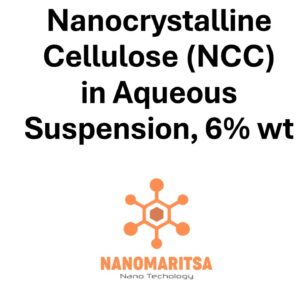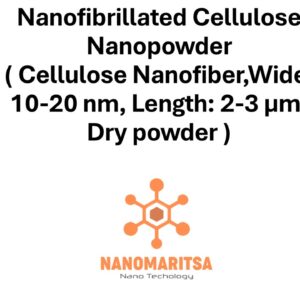Nanocrystalline Cellulose Nanopowder ( CNC, Wide: 10-20 nm, Length: 300-900 nm, Dry powder )
€160.00
CompareNanocrystalline Cellulose (CNC) Nanopowder is a high-performance, sustainable nanomaterial derived from natural cellulose sources. With a width of 10–20 nm and length of 300–900 nm, this dry powder features exceptional mechanical, optical, and rheological properties, making it a valuable material for applications across industries such as composites, biomedical engineering, coatings, and energy storage. Its renewable origin and biodegradability further highlight its potential for environmentally friendly and sustainable technologies.
1. Key Properties
High Aspect Ratio: The nanometer-scale width and length of CNC give it a high aspect ratio, enhancing its reinforcing capabilities in composite materials.
Mechanical Strength: CNC exhibits remarkable tensile strength and stiffness, making it an excellent reinforcing agent in polymers and other matrices.
Surface Chemistry: The material’s surface contains hydroxyl groups that can be chemically modified, improving compatibility with a variety of materials and applications.
Optical Transparency: CNC suspensions can be highly transparent, making it suitable for use in optical films and coatings.
Renewable and Biodegradable: Derived from natural cellulose, CNC is both renewable and biodegradable, aligning with the goals of sustainable manufacturing.
Thermal Stability: CNC offers good thermal stability, allowing it to be processed at moderate temperatures without degradation.
2. Applications
Reinforced Composites: CNC is widely used as a reinforcing agent in polymer matrices, improving mechanical strength, thermal stability, and dimensional stability in automotive, aerospace, and construction materials.
Biomedical Engineering: The material is used in wound dressings, drug delivery systems, and scaffolds for tissue engineering due to its biocompatibility and mechanical properties.
Coatings and Films: CNC is employed in coatings to improve mechanical strength, water resistance, and transparency in applications such as packaging, optics, and electronics.
Energy Storage: In energy storage systems, CNC is used to develop advanced separators and binders for lithium-ion batteries and supercapacitors.
Rheology Modifier: CNC acts as a rheology modifier in paints, cosmetics, and food products, improving viscosity and stability.
Sustainable Packaging: Its barrier properties against oxygen and water vapor make CNC a suitable material for eco-friendly packaging solutions.
Conductive Composites: Functionalized CNC can be used to develop lightweight, conductive composites for electronic applications.
3. Advantages
Renewable and Sustainable: As a natural material, CNC is an environmentally friendly alternative to synthetic nanomaterials, contributing to reduced environmental impact.
Lightweight and Strong: CNC enhances the mechanical performance of materials without significantly adding weight, ideal for high-performance and lightweight applications.
Customizable Surface Chemistry: The hydroxyl groups on CNC enable chemical modifications to tailor its properties for specific applications.
Biocompatibility: Its compatibility with biological systems makes CNC safe for use in biomedical and pharmaceutical applications.
Enhanced Barrier Properties: When incorporated into films and coatings, CNC improves resistance to water, oxygen, and other permeants.
4. Recent Trends and Research
Functionalized CNC: Research is focusing on chemically modifying CNC surfaces to enhance compatibility with polymers, metals, and ceramics, broadening its application scope.
Energy Applications: Efforts are underway to use CNC in next-generation energy storage systems, such as solid-state batteries and fuel cells, to improve safety and efficiency.
Smart Materials: CNC is being explored for use in smart materials with responsive properties, such as shape memory and stimuli-responsiveness.
Biomedical Advancements: Studies are investigating CNC for controlled drug delivery systems, bioactive coatings, and advanced wound healing solutions.
Recyclable Composites: CNC-based composites are being developed for recyclability and biodegradability, aligning with circular economy goals.
5. Future Prospects
Advanced Manufacturing: The use of CNC in additive manufacturing and 3D printing is expected to grow, enabling the production of lightweight and strong components.
Sustainable Packaging: CNC-based packaging materials will gain traction as industries prioritize reducing plastic waste and adopting renewable alternatives.
Energy Storage Solutions: CNC will play a vital role in developing lightweight, efficient, and eco-friendly components for batteries, supercapacitors, and fuel cells.
Biomedical Breakthroughs: The material’s biocompatibility and mechanical properties position it for future innovations in regenerative medicine and drug delivery.
Electronics and Optics: Functionalized CNC will continue to expand its role in electronic devices and transparent films, supporting the miniaturization of technologies.
Nanocrystalline Cellulose Nanopowder (CNC, Width: 10–20 nm, Length: 300–900 nm, Dry Powder) offers a unique combination of mechanical strength, versatility, and sustainability. Its renewable origin and multifunctionality make it a pivotal material for addressing modern challenges in technology, energy, and environmental sustainability.
| Measurement (gr) | 100 grams, 500 grams, 1000 grams |
|---|




